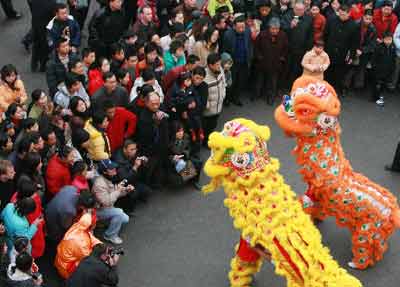For more than 2000 years, Chinese people have used brilliant colors. Today in modern China, red is a very popular color. However, contrary to popular belief, ancient peoples did not pay particular attention to the color red.
Traditional Chinese physics taught that the five elements are water, fire, wood, metal and earth, in that order. They correspond to black, red, blue, green, white and yellow, respectively. Ancient Chinese believed that all five elements in nature. Five thousand years during the reign of Huang Di (known as the Yellow Emperor) people actually worshiped the color yellow. From that time forward, through the Shang, Tang, Zhou and Qin dynasties, China's emperors used the theory of five elements for color selection. Because people understood that "colors come naturally while black and white are the first," they gradually established a relationship between colors and the principle of five elements, which guided the natural movement of heaven and the heavenly Tao. People chose clothing, food, transportation and housing in accordance with the natural change of seasons - from spring to summer and autumn, and then in the winter. Traditional Chinese attitudes about black, red, blue, green, white and yellow as standard colors
I-Ching , or Book of Changes , as far as the black sky color. saying: "Heaven and earth of mysterious black" was rooted in the claim that the northern sky was black for a long time. White Gold represents and symbolizes light, purity, and fulfillment. White is the color of mourning.
Chinese people, both ancient and modern, cherish the color red. Red was everywhere during Chinese New Year and other holidays and family gatherings for it symbolizes joy and happiness. Unfortunately, since the download Communist China, red is used by the Chinese Communist Party to represent danger, blood, violence and radical actions.
Blue-green indicates spring when everything overflows with vigor and vitality.Yellow symbolizes the earth. An old proverb says, "Yellow generates Yin and Yang," meant that the yellow center of everything. Color embodies an even richer culture in Chinese folk traditions. Yellow is the color for emperors. Yellow often decorates royal palaces, altars and temples. Yellow is free from worldly cares. Therefore, it is also a color respected in Buddhism.
Chinese culture created a close and binding relationship between color and ceramics, murals, paintings, and poetry ... even urban planning. Many of the silk goods unearthed from ancient tombs have maintained their original color of brown, red, black, purple and yellow. Chinese pottery and lacquer goods uses rich color even more extensively. formulation of richly colored glazes pervades these works with a brilliant and shiny appearance. For the ancient Chinese, food coloring spirit and expresses the depth of human experience.

No comments:
Post a Comment